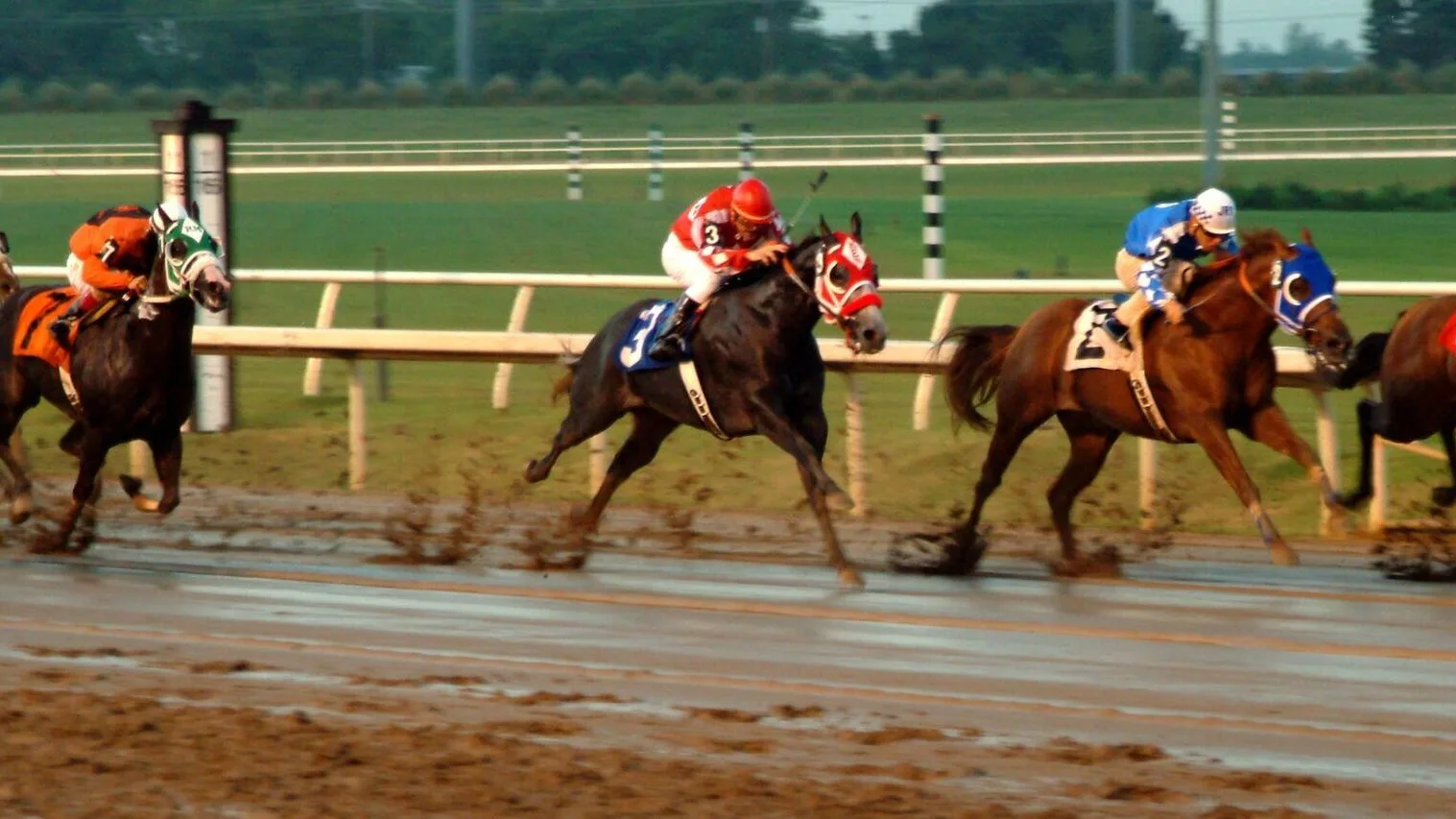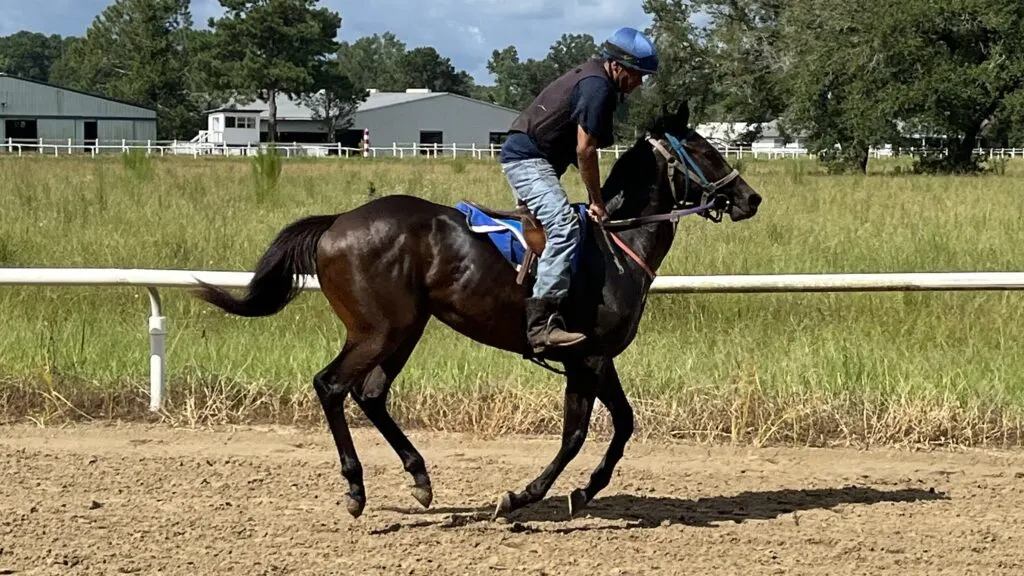Last updated: March 1, 2024
Did you know that racehorses can pee up to 10 gallons a day? This astonishing fact often surprises many horse owners and enthusiasts. As someone who has owned and been raised around race horses for years, I’ve observed firsthand the frequent urination of racehorses.
This phenomenon piques curiosity and raises important questions about health and management practices of horses. Understanding why race horses pee so much is crucial for their care and enhancing their performance on the track.

Why Racehorses Pee So Much: Understanding the Key Factors
Racehorses are celebrated for their speed and endurance, yet their frequent urination is a notable aspect of their physiology that intrigues caretakers and enthusiasts. This behavior is influenced by several key factors:
1. The Role of Lasix:
- Medication Use: Lasix, a diuretic prescribed to prevent pulmonary bleeding, significantly increases urine production by removing excess body fluids. Learn more about pulmonary bleeding in racehorses.
- Dual Purpose: Beyond health benefits, Lasix’s fluid expulsion leads to weight loss, potentially offering a competitive advantage but also resulting in increased urination.
2. Hydration and Exercise Regimen:
- Intense Training: The demanding exercise routines of racehorses elevate their water intake needs, making proper hydration essential for their health and performance.
- Natural Response: Increased fluid intake naturally leads to more frequent urination, helping to eliminate toxins and regulate body temperature post-exercise.
3. Diet and Nutrition:
- High-Protein Feeds: Diets rich in protein produce more nitrogen waste, expelled through urine, thus increasing urination frequency.
- Electrolyte Management: Proper management of electrolytes, crucial for fluid balance and muscle function, directly affects hydration and urination patterns.
4. Health Monitoring:
- Veterinary Oversight: Regular veterinary check-ups are vital for assessing the impact of diet, exercise, and medication on racehorse health. Increased urination may indicate underlying issues requiring professional attention.
Understanding the interplay of these factors sheds light on the managed and natural aspects of a racehorse’s life contributing to frequent urination. It’s about balancing performance optimization with health and well-being.

Lasix’s Role in Horse Racing, and its Impact on Urination
Lasix, or Furosemide, is a diuretic medication pivotal in horse racing, known for its ability to increase urine production and remove excess body fluid. Its adoption in the racing industry is largely due to its health and performance benefits.
Why is Lasix Used?
- Combatting EIPH: By lowering blood pressure, Lasix reduces the severity of Exercise-Induced Pulmonary Hemorrhage, minimizing the risk of lung bleeding during high-intensity activities.
- Weight Management: Lasix’s diuretic effect causes rapid weight loss, potentially giving racehorses a competitive advantage by lightening their weight for enhanced speed. Learn more about weight loss in races.
Citation: Explore the effects and regulation of furosemide in horse racing through the comprehensive review by Soma, L. R., & Uboh, C. E. (1998) in the Journal of Veterinary Pharmacology and Therapeutics.
Here is a YouTube video that debates the pros and cons of Lasix use.
Risks Associated with Lasix Use in Racehorses
- Dehydration and Electrolyte Imbalance: Significant fluid loss from Lasix use can cause dehydration and disrupt critical electrolyte balance, affecting muscle function and health.
- Long-term Health Concerns: Continuous Lasix administration may strain the kidneys and increase the likelihood of musculoskeletal injuries by affecting bone density.
Despite its widespread acceptance and legal use across many racing jurisdictions, the long-term health effects of Lasix on horses and the ethical considerations surrounding its use for enhancing performance remain contentious topics.

Exercise and Stress Factors in Racehorses
Racehorses face rigorous training and racing schedules, pushing their physical limits and imposing significant stress on their bodies. This combination of physical exertion and the psychological pressures of competition can markedly affect their urinary patterns, often leading to more frequent urination.
Physical Stress from Training and Racing:
- Increased Metabolism: Intense exercise boosts a racehorse’s metabolism, speeding up waste production that the kidneys must filter and expel, thus increasing urination.
- Body Temperature Regulation: To dissipate exercise-induced heat, racehorses sweat and increase blood flow to the skin. Post-exercise, the need to rehydrate and cool down can lead to increased thirst and urination.
Impact of Stress Hormones:
- Cortisol and Adrenaline: The stress of competition or intense training releases hormones like cortisol and adrenaline, stimulating the kidneys to produce more urine.
- Kidney Function and Urine Production: These hormones can change how kidneys filter blood and manage water and electrolytes, often causing more frequent urination.
- Fluid Retention and Release: Initially, stress hormones may lead to fluid retention. After the stressor passes, the body releases this fluid, increasing urination.
Managing Exercise and Stress-Induced Urination:
- Balanced Training Regimens: Well-planned training with adequate rest helps manage physical stress, moderating its impact on urination patterns.
- Stress Reduction Techniques: Techniques to reduce psychological stress, such as maintaining a calm environment, can lessen stress hormones’ effects on kidney function and urination.
- Monitoring Hydration: It’s crucial to monitor water intake and urine output, especially after intense activities, to ensure proper hydration and early identification of potential health issues.

The Role of Hydration in Racehorse Health
Hydration is crucial for racehorses, affecting their health, performance, and recovery. Given the intense demands of training and racing, ensuring these athletes are properly hydrated is key.
Why Hydration Matters:
- Essential for Bodily Functions: Water supports digestion, nutrient absorption, and temperature regulation, all vital for maintaining a racehorse’s peak condition.
- Boosts Performance: Proper hydration optimizes muscle function, minimizes heat stress, and enhances post-exercise recovery.
- Prevents Dehydration: The risks of dehydration include electrolyte imbalance, reduced blood volume, and overheating, which can severely impact health and performance.
Impact on Urinary Frequency:
- Natural Increase in Urination: Adequate hydration leads to more frequent urination, a natural process for managing fluid levels and eliminating toxins, particularly crucial after strenuous activity.
- Health Indicator: Urine frequency and color indicate hydration levels and health status; dark urine suggests dehydration, while clear urine indicates good hydration.
Overall Health Benefits:
- Kidney Health: Hydration facilitates efficient waste filtering by the kidneys, helping prevent urinary tract issues.
- Blood Volume Maintenance: Proper hydration ensures sufficient blood volume, supporting cardiovascular health essential for endurance.
- Recovery Aid: Replenishing fluids lost through sweat aids recovery, supports muscle repair, and prevents cramps.
Ensuring racehorses have access to ample water, especially post-exercise and during hot conditions, is vital for their well-being.

Impact of Diet on Urination in Racehorses
The diet of a racehorse significantly influences not only its performance and recovery but also its urination patterns. A well-planned diet is key to maintaining the health and well-being of these elite athletes.
High-Protein Feed and Supplements:
- Increased Nitrogen Waste: High-protein diets support muscle repair and growth but also increase nitrogen waste, leading to more frequent urination as the body eliminates these byproducts.
- Monitoring Protein Intake: It’s crucial to balance protein intake to avoid overburdening the kidneys and risking dehydration from increased urination.
Electrolyte Balance and Its Importance:
- Essential for Hydration: Electrolytes like sodium, potassium, and chloride are vital for fluid balance and directly influence urine production.
- Managing Electrolytes: Maintaining electrolyte balance is crucial, especially as racehorses lose significant amounts through sweat. Imbalances can cause excessive urination or dehydration, affecting health and performance.
- Supplementation: Carefully managed electrolyte supplements can help replenish losses from exercise, supporting hydration and healthy urination patterns.
Dietary Adjustments for Optimal Urine Production:
- Tailored Feeding Plans: Adjust protein and electrolyte levels based on the horse’s exercise intensity, environmental conditions, and health to effectively manage urination.
- Hydration Strategies: Constant access to clean, fresh water is essential. Proper hydration supports kidney function and manages increased urine production from dietary intake.
A racehorse’s diet directly impacts its urination patterns. Properly balancing high-protein feeds and electrolyte management is crucial to prevent increased urine production and potential health issues.

Health Concerns and Monitoring
In horse racing, scrutinizing every aspect of a racehorse’s health is standard. Increased urination can signal underlying health issues, making understanding these potential concerns vital for the well-being of these elite athletes.
Potential Health Issues:
- Kidney Problems: Issues like kidney infections, stones, or chronic kidney disease can increase urination as the body tries to remove waste more frequently.
- Urinary Tract Infections (UTIs): These can irritate the bladder, leading to more frequent urination, discomfort, and possibly blood in the urine.
- Diabetes: Though rarer in horses than humans, diabetes can cause increased thirst and urination to eliminate excess sugar.
The Importance of Regular Veterinary Check-ups:
- Early Detection: Regular check-ups enable early detection of issues, allowing for quicker intervention and recovery.
- Comprehensive Health Monitoring: Veterinarians perform tests like blood work and urinalysis to monitor a horse’s health, identifying urinary and other health concerns.
- Tailored Care Plans: Veterinarians can recommend specific care plans based on the horse’s health, including dietary adjustments and medication.
Proactive Health Management:
- Hydration and Diet: Access to clean water and a balanced diet supports urinary tract health and overall well-being.
- Environmental Management: Maintaining clean stabling conditions and proper exercise management can prevent health issues leading to increased urination.
- Observation: Caretakers should watch for signs of discomfort or changes in urination patterns as early indicators of health issues.

FAQs on Horse Urination
How much urine do horses typically produce daily?
Horses generally urinate about 2.5 gallons per day, depending on factors like fluid intake, age, weather, feed, and size.
What should healthy horse urine look like?
Normal horse urine should be clear with a yellow tint and minimal odor. It should be expelled easily and in a steady stream.
What are some health indicators based on a horse’s urine?
Pale urine indicates good hydration, dark yellow may suggest concentrated urine due to less water intake or excessive sweating, and cloudy urine can be diet-related. Any significant changes or abnormalities in urine should prompt a veterinary consultation.
Do racehorses urinate more than other horses?
Racehorses and regular horses urinate roughly the same amount. However, racehorses on Lasix urinate more due to the drug’s diuretic effect.
What is the significance of the phrase “pee like a Russian racehorse”?
This phrase is often used to describe an urgent need to urinate. In the context of racehorses, it refers to the increased urination seen in racehorses on Lasix, especially before a race. It likely started a “Rushing Racehorse,” not Russian.
Conclusion: Why Race Horses Pee So Much
We’ve explored the multifaceted reasons behind the frequent urination observed in racehorses, highlighting the significant impact of hydration, diet, medication, exercise, and stress on their urinary patterns. Each factor plays a crucial role in the overall health and performance of these elite athletes, underscoring the complexity of their care and management.
Key Points Recap:
- Hydration and Diet: Proper hydration and a balanced diet, especially regarding protein and electrolyte levels, are fundamental to maintaining healthy urination patterns and overall well-being in racehorses.
- Lasix Use: The administration of Lasix, a common diuretic in the racing industry, significantly increases urine production to prevent Exercise-Induced Pulmonary Hemorrhage (EIPH) and manage weight, yet it brings along considerations regarding health and ethical use.
- Exercise and Stress: The physical demands of training and racing, coupled with the psychological stress of competitive environments, can alter urination frequency through metabolic changes and the influence of stress hormones on kidney function.
Call to Action: Share Your Insights and Learn More
We invite our readers to share their experiences and tips on managing racehorse health and hydration. Your knowledge and practices could greatly benefit others in our community, fostering a deeper understanding and better care for these magnificent animals.
Further Reading and Resources:
For those eager to expand their knowledge on equine care, especially regarding hydration and overall health, we recommend the following authoritative resources:
- The Horse: Your Guide to Equine Health Care – Offers a comprehensive article titled “Horse Hydration: Your Questions Answered” by Alexandra Beckstett, providing valuable insights into horse hydration from equine nutritionists.
- American Veterinary Medical Association (AVMA) – Provides a wealth of information on horse health care, covering various topics essential for horse owners and caretakers.
- Stable Management – Features an article on “Answering Your Horse Hydration Questions”, offering practical advice for managing equine hydration effectively.
- PubMed Central (PMC) – Hosts a detailed study on “Oral Electrolyte and Water Supplementation in Horses”, providing scientific insights into the benefits of electrolyte supplementation.
Noteworthy Study:
- A study featured in Thoroughbred Daily News, “Study: Horses On Lasix At Increased Risk of ‘Sudden Death‘,” conducted by Dr. Euan Bennet and Dr. Tim Parkin, found a 62% higher risk of sudden death within three days of racing for horses on Lasix compared to those not on the diuretic. This research, analyzing data from 284,387 Thoroughbreds across 144 North American racetracks from 2009 to 2021, prompts a reevaluation of race-day Lasix use due to safety and ethical concerns.
Poll Question
Related Articles:
Meet Miles Henry
An avid equestrian and seasoned racehorse owner, Miles Henry brings his extensive experience to the equine world, proudly associating with the AQHA, The Jockey Club, and various other equine organizations. Beyond the racetrack, Miles is an accomplished author, having published various books about horses, and is a recognized authority in the field, with his work cited in multiple publications.
🔗 Connect with Miles:
Twitter
Facebook
YouTube: Check out race highlights, horse care tips, and more!

